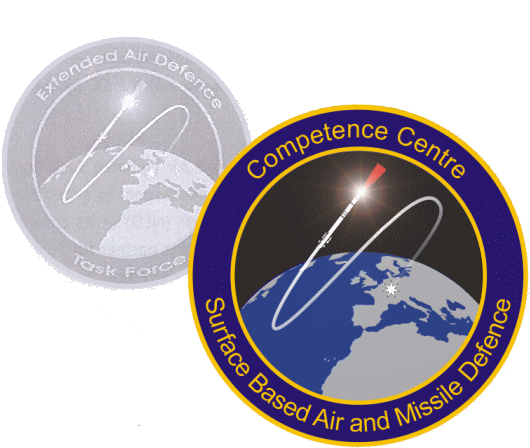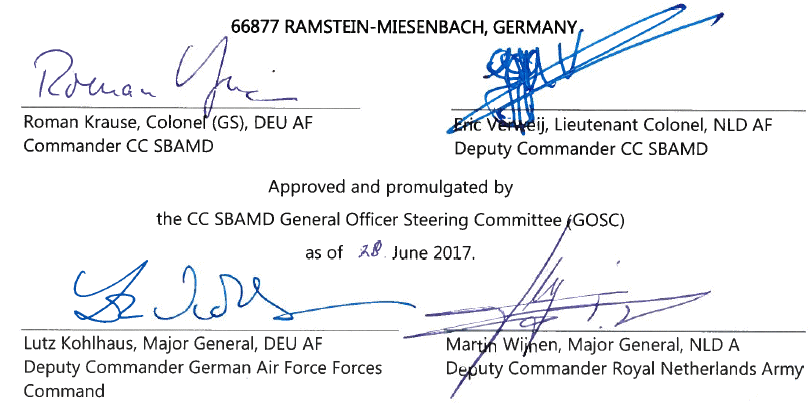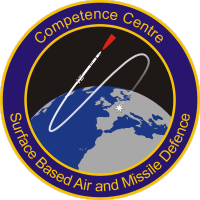
COMMAND GROUP’S VISION
FOR THE COMPETENCE CENTRE
SURFACE BASED AIR AND MISSILE DEFENCE
(CC SBAMD)
66877 RAMSTEIN-MIESENBACH, GERMANY

This CC SBAMD Command Group’s Vision supersedes the previous vision as of 08 September 2014.
Aim. The Competence Centre for Surface Based Air and Missile Defence (CC SBAMD) Command Group’s Vision articulates the focus and priorities of the CC SBAMD as approved and promulgated by the CC SBAMD GOSC.
Achievements and Values. Capitalizing on the Extended Air Defence Task Forces’ (EADTF) heritage, the CC SBAMD signifies a major achievement with respect to a credible and trustful cooperation between Germany (DEU) and The Netherlands (NLD) as its current sponsoring nations (SN). The CC SBAMD will maintain the status as prime partner for Surfaced Based Air and Missile Defence (SBAMD) at tactical, operational, military strategic and policy level.
Mission Statement. The CC SBAMD will provide to its SN, their allies & partners premier joint expertise, operational level capabilities and training capacities for advancing the SBAMD mission within the Integrated Air and Missile Defence (IAMD) domain.
Vision. The CC SBAMD will steadily monitor and assess the current threat situation, stands ready to accept demanding IAMD related challenges and will continue to observe the developments and interdependencies within the European IAMD context. Based on the mission statement, five key features will characterize and shape the CC SBAMD as an organization as well as its work and communication relations:
(1) Jointness. The IAMD domain is joint in nature. Thus, CC SBAMD’s core competencies must reside at the joint and operational level. All subsequent Programs of Work (PoW) and not least the manning will reflect the jointness of the common endeavour.
(2) Combinedness. With DEU and NLD leading in the field of SBAMD, CC SBAMD will help paving the way for integrating multinational initiatives and must therefore remain open for nations’ participation. While the DEU-NLD Project APOLLO serves the multi-vignette integration of SBAMD at the tactical level, CC SBAMD will complement this effort with its inherent operational level expertise and integration potential.
(3) Operational relevance. Retaining a high level of operational excellence expresses the CC SBAMD’s unique orientation towards operational involvement. The co-location with HQ AIRCOM is a fundamental requirement for this role relevant to the IAMD mission at the operational & tactical level.
(4) Flexibility. The organization’s immediate availability and responsiveness makes CC SBAMD extremely approachable for short notice interaction with all its stakeholders and partners. NATO will remain a premier ‘customer’ for the CC SBAMD, as well as it is the first source of current information and IAMD ‘thinking’. However, the CC SBAMD will not strive for an accreditation as a NATO Centre of Excellence (COE) in order to maintain its high degree of independent action on behalf of its SN.
(5) Prime Integrator for SBAMD. Interacting with the Information Knowledge Network (IKN), the CC SBAMD will generate consolidated solutions for the SN and partners while exploiting the potential to catalyse and guide multi-lateral SBAMD efforts.
Based on its capabilities, developing threats and near-future trends, the PoW will adapt to the ever-changing needs and will focus on the CC SBAMD’s core disciplines in IAMD:
- Technology
- TTPs
- Operations
- Training
- Policy
These disciplines are inherently interlocking, and consequently, serving both the provision of first class advice to all stakeholders and partners as well as preserving leading levels of expertise within the organization.
The CC SBAMD will continuously strive to be a crucial element in support of the NATO’s Smart Defence, the Framework Nation Concept’s AMD cluster including the APOLLO project and will act as a knowledge repository and provider of most current expertise in the field of SBAMD as directed by its SN.
